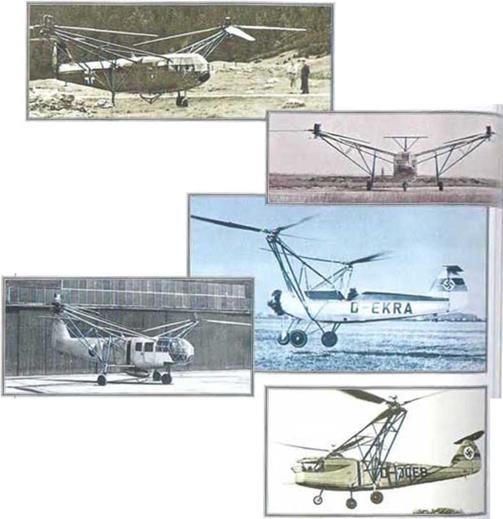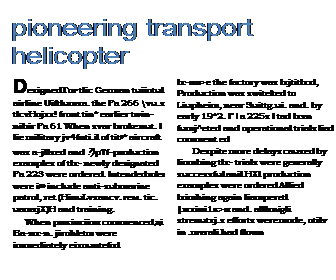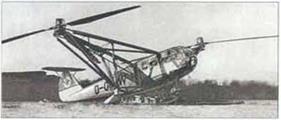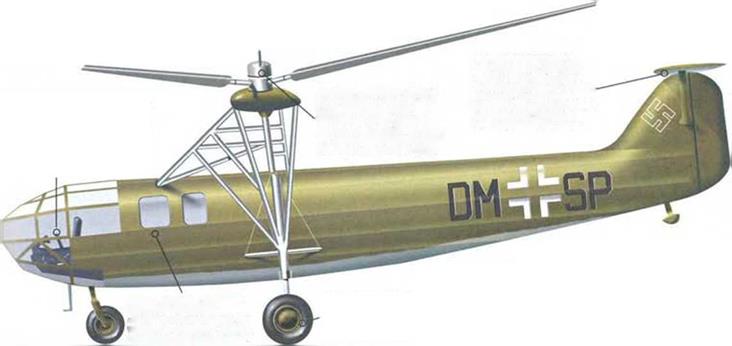• Transport helicopter • Twin-rotor layout • Post-war service
In the years immediately preceding World War II Germany had become one of the world’s leading helicopter nations. In 1932 Prof. Heinrich Karl Focke began a series of experiments commencing with licence-built autogyros and culminating in the Fa 266 Hornisse. This outrigger-mounted twin-rotor design was the world’s first genuino transport helicopter, and when war arrived it was developed for military use as the Focko-Achgelis Fa 223 Drache.
Focke-Achgelis Fa 223 Drache

Rotor position ►
To provide a stable lifting platform the rotors were positioned on outriggers on cither side of the fuselage. This allowed larger blades to be used.
Indoor flight ►
Prior to the outbreak of World War II the helicopter was seen as a tool for propaganda use, with flight demonstrations oven taking place at indoor conferences.
A Post-war service
After World War II, two Fa 223s were constructed in Czechoslovakia from German-manufactured aircraft components. Thoy saw limited service.
Early birds ►
Numerous configurations were tested before a practical design was adopted for operational use with tho Luftwaffe dunng the war.
FACTS AND
> Tho first night of tho Fa 223 Dracho
occurred in August 1940. Tho project was under military control.
>■ After the first successful flight, 39 pre-
production oxamplos wore ordered.
FIGURES
► Ono variant was to be fitted with machine guns and two 250-kg (550-lb.) bombs for armed reconnaissance missions.
► An Fo 223 bocamo tho first hnlicoptor to cross tho English Channel.
► Tho roles envisaged for tho Dracho were roscuo and anti-submarine patrols.
After the war both Franco and Czechoslovakia developed the design.
|
Focke-Achgelis Fa 223 Drache
|
|
|
|
 |
|
Fa 223 Drache
Type: I’itnsport/rescoo/rocormatssanco helicopter
Powe/plant: one 746-kw (1.000-ftp» BMW 301 R rwie-cytnder radial engji*
|
|
|
Loft: Unconventional in layout, tho Fa 223 Drache proved itself a highly capable helicopter during the war.
|
|
|
Maximum speed: 175 kmli <109 m p. h)
|
|
|
by 1911 Пн? Fa 223 did. however, demonstrate many oi the roles that tlx – helicopter Іш made its «mm in the postwar years. Successful rescue missions using a windi were carried ihii and deployments tit troops to сої (lined areas wen – also achieved by Luft-Tr. insjv>nslalTel *0. Only three machines were seniei-ahle Ivy tlx- end of tlx – wai. iikI one ol tlx-se Ixvame the first Ііеіісчцмс-г to rmss the Fnglish Channel
|
|
|
Cruising speed: :20 km/h (74 m p h)
|
|
|
Range: 700 km (434 mi ), wrth luxilmry tuot tank
|
|
|
Service ceiling: 2010 m <6.600 ft,»
|
|
|
Weights: empty 3175 kg (6.965 lb); maximum hike oft 4310 kg 19.490 lb)
|
|
|
Armament: one 7 92-mm MG 15 machine-gun and two 250-kg (550-lb.) bombs
|
|
|
Dimensions:
span tang tli height
rotor disc area
|
|
|
Above: The prototype Drache was initially flown tethered to the ground to allow the pilot to explore its handling safely.
|
|
|
24.5 m (80 ft. 4 in.) 12.25 m <40 ft 2 In.) 4.35 m (14 ft. 3 mg 22619 m’ (2.434 sq. ft.)
|
|
|
|
|
After numerous truss thn taf ccf*rjuta:on that oftorod tho bant twitting quaktios during the hovtnng photo was a high – . lot design The.-iKmxxi thn Oracho to тако pmetso lanotngi at mountan hot pods imc wfson МУ loadod wrth troop*.
|
|
|
|
|
ОмрХі ‘I» ivMSviily largo wo. th* Fa Щ ivjo good portormanc* and was toalar men iho Amoncan Skoniky Ho>«rtty and lh* Ugh»- we^tit observation Ft 282 Ко*bn Such hne performance ai*o meant Hull ti’o r n 223 cmid cpwalo л mtrry ditticun locaicm
175 kn.1i |IM т а к |
|
|
|
f*06.poneo on outilggera the twin rators were poweied try я wvjte nmo cy+ndor галаі engcie. Providing enough power tar the ho*cop! or was a particular problem that Iho makws hod to cwarcomo n о’da to achieve rwrory packing.
|
|
|
A heawv -»ueocJ cockpit лГспкжі tho |i4ot I »»*•>: vwhaty, partcuUirv wr-on ccmng л to tarxl агчл a downword vww was mqurro PAji, found Іію Omcrto пХлІглУу way to master era tho, u. /JaiiLTcar. itrxi by two German plotr. fiyrifl ono across tho Ovr-otf to Bntan fet noU! «і ні їїm сопскйюп of YAJrttJ War»
|
|
|
|
|
 |
|
Ч’7^Г’Ґ
•v V*
746 kW (1.030 hp.)
<»"r>
•; о •’—
W
111 kW (110 hg-l
|
|
 |
|
SuCOMnAtri tyra» won» ГпЧя» to tie Fa 223 Dnrho to Mow tho r**:optrs to :.vxi on i/uxoparcd arfaikli. The» wem artaptod firm othtx Gorman transport ivraaft Stoonng on tho i/turv) was orxcrrpWvvi through tho large norm w**el
|
|
|
Roto# onvtsagod tor ttvo Drnchci were batMMd transport, obsorvaton and rescue work For mo last of these an extra tud tank and rescue winch wore provided
|
|
|
|
|
|
|
 |
 |
|
RFIETTner FI 282 KOUBRI: Used as an observation! T^fcPt it-.– FI 282 war. operated by tho Gorman navy allowing rjjrcar – i n – to v«w Allied shipping over tho horizon
|
|
|
■ HAFNER R-11: Utilising a standard army Wflyo |eep. die English company Hefner adapted the vehicle to be used as a battietietd air observation platform The protect met with limited success and was soon cancelled.
|
|
|
H SIKORSKY R-4: Rvi most successful heliOOptef ot World War It. the R-4 was used in the rescue and scout roles and saw extensive service m the Pacific tlveatre.
|
|






Hiller























